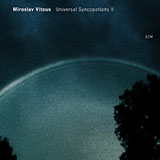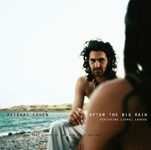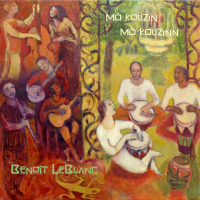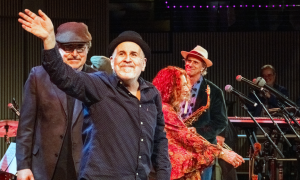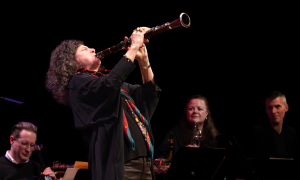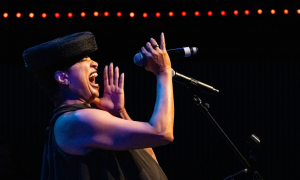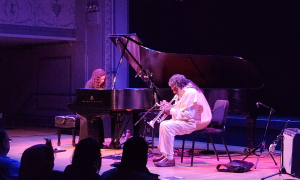Home » Jazz Articles » Live Review » 6th Rochester International Jazz Festival, Part 3
6th Rochester International Jazz Festival, Part 3
Rochester International Jazz Festival 2007—6th Edition
Rochester, New York
June 8-16 (Part 3)
Hilario Duran Trio
Max Of Eastman Place
June 13, 2007
Hilario Duran: piano; Roberto Occhipinti: bass; Mark Kelso: drums
There was a strong Latin presence at this festival with several local bands playing the free stage. Cuban pianist (by way of Canada) Hilario Duran is one of most accomplished in this music. Not as well-known as Gonzala Rubalcaba or Omar Sosa (who also played the festival this year), Duran is one of the finest pianists combining a Latin rhythmic sense with a solid jazz grounding. He first played Rochester back in the mid-90s as a member of Jane Bunnett's Spirits of Havana band, in which he stood out among the battery of 10 strong musicians. Since then he's gone his own way and put out a fine series of recordings on Justin Time and Alma.
He started his set with Tadd Dameron's bebop classic, "Hot House." While the tune was played in a relatively straightforward manner, it was framed by a Latin intro and coda that suddenly took the music into some complex rhythmic interplay guaranteed to trip up many a foot tapper. The bulk of the set was comprised mostly of originals, and Duran writes some intriguing compositions. "Yamaya Olodo starts with a characteristic Cuban figure that has some uncharacteristic harmonic elements. Midway through, the music switched to straight ahead swing, and the effect was magical. Occhipinti and Kelso were a dynamic rhythmic section, well versed in both styles and capable of following this music anywhere. Duran's piano style has the full bodied harmonic approach favored by most Cuban pianists (Duran at times sounded a bit like McCoy Tyner), but he will frequently pare the music down to simple single note lines splashed with dissonances worthy of Monk. By the time he left, Duran had shown audiences just how dynamic Latin piano trio music can be, shorn of the flash and splash that smothers the music of some practitioners of this style. Duran delivered solid, straightforward Latin piano trio music, and his music was all the stronger for it.
Matt Wilson Arts & Crafts
Montage
June 13, 2007
Matt Wilson: drums; Michael Rodriguez: trumpet; Gary Versace: piano, keyboards, organ; Dennis Irwin: bass
Matt Wilson has led a couple of bands at the festival in years past, and this year he brought his Arts & Crafts group. Once again the venue filled up quickly (capacity around 250), even though it was the late show. The most recent Arts & Crafts disc, The Scenic Route, has proven to be popular in this area. They took the stage for the second set seemingly ready to go.
This is a fascinating group and shows Wilson's ingenuity in forming a band and making it work. Wilson has a wide-open view of modern jazz, and he's fond of pulling out obscure compositions by Ornette Coleman, Jaki Byard, Donald Ayler. The group led off the second set with a rousing version of Rahsaan Roland Kirk's "Stompin' Ground." But what's even more interesting than the interpretation of the music of jazz legends is that Wilson writes his own first-rate compositions. In "Free Range Chicken," Wilson has written the best jazz farm tune since the Art Ensemble of Chicago's "Barnyard Scuffle Shuffle." He announced it with pride, saying it won "The American Poultry Association's award for best jazz farm tune of the year. It's their equivalent of a grammy. It has a great rhythm—Wilson's drumming on the piece reminded me of Billy Higgins. With funky organ fills from Versace and great squawking muted work from Rodriguez, this tune was one of the highlights of the festival for this review.
Terrell Stafford was originally announced as the trumpet player, but Michael Rodriguez was a substitute. His playing was superb, confirming the terrific work he did on Charlie Haden's most recent Liberation Music Orchestra disc. They followed that up with a lovely ballad by Brazilian Nelson Cavaquinho, "Beija Flor." The group ventured credibly toward the outer fringes on "In Touch With Dewey," dedicated to saxophonist Dewey Redman, in whose band Wilson manned the drummer's chair for 12 years. Concluding with a singalong and processional leading the audience out to the streets on "Give Peace A Chance," Wilson and company left everyone happy after delivering one of the more talked-about sets of the festival.
Jason Moran & The Bandwagon
Montage
June 14, 2007
Jason Moran: piano; Taurus Mateen: electric bass; Nasheet Waites: drums
It seemed that everyone I spoke to was waiting for this set. Moran played Rochester once before—in a duet with Marian McPartland, oddly enough. But those who were only familiar with him in that context were in for a surprise. It seemed most people were familiar with the Bandwagon album, but this is a piano trio trying to expand outwards beyond that format's limitations.
Among other things, Moran incorporates samples of spoken speech, using the speech patterns as the rhythmic basis for the music. The samples used during this set were very different from the ones used on the disc. But as forward-looking as Moran is, he's always mindful of the music's past. As the music flashed by, I caught a wonderful revision of Monk's "Crepescule With Nellie when the trio toyed with various phrases of the tune, always hinting at the piece but never quite bringing it out until the very end. A little later in the set, Monk's "one-note theme "Thelonious surfaced, a heavy gospel influence permeated one section. It was a terrific set and had me so wrapped up in it that I neglected to take many notes. Waites made his second appearance at the festival, and his playing on this set was quite different from his playing during the Fred Hersch set, once again confirming what a complete drummer he is. Moran seemed genuinely involved in the music and, including the encore, the set ran a little over the allotted time. The audience was definitely with the trio all the way, and Moran seemed appreciative of the reception.
In The Country
Lutheran Church Of The Reformation
June 14, 2007
Morten Qvenild: piano, keyboard, vocals; Roger Arntzen: bass, vocals; Pal Hausken: drums, percussion, vocals
After Moran's set ran overtime, it was a quick jaunt back up to the Church for another group in the Nordic Jazz Now series—Norwegian trio In The Country. Once again the venue was packed. There was a little buzz on this one, since their recent album Losing Stones, Collecting Bones has been getting good reviews.
On paper, In The Country looked like a fairly straightforward proposition: a piano trio. But in their own way, much like Moran, they're trying to carve their own individual space in this format. Once the music started, one realized this group was doing things a little differently. First of all their music tended to operate at the quieter end of the spectrum. Pianist Qvenild shows the influence of Paul Bley, both harmonically and in his use of space. There's a little bit of Keith Jarrett in there as well. At times one could describe this music as Satie-esque. Drummer Hausken plays a standard kit, but it's outfitted with all sorts of extraneous things: bells, wooden objects. He would cover his toms and snares with cloth to achieve that odd muted sound so prevalent on the disc. Occasionally he would play a glockenspiel, doubling the melody or playing counterpoint, which was a nice touch.
The rhythmic drive of this music is not exactly jazz-based. It seemed much more rock-based. This is not necessarily a bad thing, since Hausken is a fine drummer. The development of the pieces tended toward rock with a rock-ish sense of drama: starting out quietly, building an idea to a climactic pitch, then arcing back. When the band launched into "Kung Fu Boys ("I wrote this song and named it after ourselves said Qvenild), I couldn't help but recall the Canterbury style of bands like Hatfield & The North. This piece could have easily been from one of that band's instrumental interludes.
While In The Country may have had a rock base, they clearly had a jazz musician's sense of spontaneity, responding to a distant church's bells that started to ring during one of the quiet portions of the set. Occasionally the trio would break into song. "Everyone's going to die, everyone in their life went one. They were personable and seemed genuinely shocked that they had such a large crowd: "We never get audiences this big back home. This is amazing! What was amazing was the music, and once again the audience left with smiles on their faces after receiving another pleasant surprise from this series.
Don Byron: Ivey-Divey
Kilbourn Hall
June 15, 2007
Don Byron: clarinet, tenor sax; Jason Moran: piano; Billy Hart: drums
This was Byron's first appearance at the RIJF and in Rochester, in general. Between songs he reminisced that he had applied to the Eastman School Of Music 20 years earlier and was rejected. (He's in illustrious company. Among others, in the 1940s Bela Bartok applied for a professorship but was passed over.) Ivey-Divey is Byron's tribute to the melodic genius of Lester Young, but like all of his projects, this one wasn't confined by its concept. The music looked both backwards and forwards to create exciting sounds of the present. Jason Moran, who was present on the original Ivey Divey album, stayed an extra day after his Bandwagon date to reprise his role. The redoubtable Billy Hart replaced original drummer Jack DeJohnette, and one could do no better as a replacement.
The trio strolled out confidently, took their places and proceeded to dissect a Lester Young standard, Gershwin's "Somebody Loves Me in a hundred different ways. Byron alternated between tenor and clarinet in two lengthy solos, and with Hart manning the drum chair, the music swung freely. Between songs Byron talked about Lester Young, referring to him as the "codifier of melodic invention" but, not being restricted by the music of Prez, Byron proceeded to show the audience what he meant by calling Coltrane's "Giant Steps as the next tune. I'm always astonished by the malleability of this tune having been done countless ways: Latin, ballad etc. Hart laid down a bossa nova pattern, and Byron proceeded to take apart the song, exposing its melodic core with beautiful chords from Moran prodding him along. This was his best tenor outing of the set. Next up was "For Himm, a contemporary spiritual written by Byron and dedicated to Kirk Franklin. Before they started, he turned to Moran and said "Do you remember your intro on this? Moran began to play, and Byron smiled as he played a magnificent introductory solo. They concluded with a rousing "I Found A New Baby that dug in deeply and swung like mad. This concert was a personal favorite of the entire festival—those who attended both shows said the second show was even better.
Tags
PREVIOUS / NEXT
Support All About Jazz
 All About Jazz has been a pillar of jazz since 1995, championing it as an art form and, more importantly, supporting the musicians who make it. Our enduring commitment has made "AAJ" one of the most culturally important websites of its kind, read by hundreds of thousands of fans, musicians and industry figures every month.
All About Jazz has been a pillar of jazz since 1995, championing it as an art form and, more importantly, supporting the musicians who make it. Our enduring commitment has made "AAJ" one of the most culturally important websites of its kind, read by hundreds of thousands of fans, musicians and industry figures every month.

